
SWBAT show their understanding of the divisibility rules.
- Subject:
- Mathematics
- Material Type:
- Lesson Plan
- Provider:
- BetterLesson
- Date Added:
- 12/01/2022

SWBAT show their understanding of the divisibility rules.

Use real-life measurement problems involving cups of sugar to learn about fractions. This video focuses on the connections between numerical and visual representations of the division of fractions.
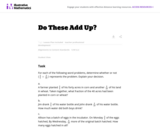
These word problems address common errors that students make when adding fractions.
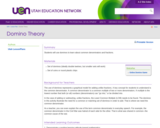
Students will use dominos to learn about common denominators and fractions

This problem involves fraction multiplication that can be solved with pictures or number lines.
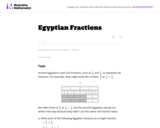
One goal of this task is to help students develop comfort and ease with adding fractions with unlike denominators. Another goal is to help them develop fraction number sense by having students decompose fractions. Because the Egyptians represented fractions differently than we do, it can also help students understand that there can be many ways of representing the same number.

In this interactive lesson, students will experience the engineering design process as an aerospace engineer assigned to design and test an airplane.

Sal determines if shapes are divided into 2 or 4 equal sections.
Khan Academy learning modules include a Community space where users can ask questions and seek help from community members. Educators should consult with their Technology administrators to determine the use of Khan Academy learning modules in their classroom. Please review materials from external sites before sharing with students.

Semonstrates how to solve an equation with variables on both sides with the example, (3/4)x + 2 = (3/8)x - 4. [4:50]
Khan Academy learning modules include a Community space where users can ask questions and seek help from community members. Educators should consult with their Technology administrators to determine the use of Khan Academy learning modules in their classroom. Please review materials from external sites before sharing with students.

Uses visual models and number lines to demonstrate the equivalency of fractions. [4:02]
Khan Academy learning modules include a Community space where users can ask questions and seek help from community members. Educators should consult with their Technology administrators to determine the use of Khan Academy learning modules in their classroom. Please review materials from external sites before sharing with students.
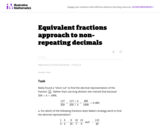
The purpose of the task is to get students to reflect on the definition of decimals as fractions (or sums of fractions), at a time when they are seeing them primarily as an extension of the base-ten number system and may have lost contact with the basic fraction meaning. Students also have their understanding of equivalent fractions and factors reinforced.
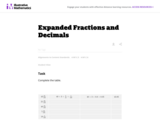
The purpose of this task is for students to show they understand the connection between fraction and decimal notation by writing the same numbers both ways.
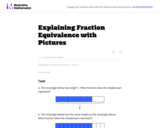
The purpose of this task is to provide students with an opportunity to explain fraction equivalence through visual models in a particular example.

In this Cyberchase media gallery, a series of videos explores the relationships among fractions, decimals, and percents, which can be used to represent the same values in different ways. In the accompanying classroom activity, students shade in parts of squares and rectangles drawn on a piece of graph paper and express the shaded amount in the form of a fraction, a decimal, and a percent.

Grades 3-6. The CyberSquad solves the problem of giving equal parts of two apples to Cerberus, the three headed dog of Greek mythology, in this video from Cyberchase.

If you like tackling formulas, then this math challenge is for you. See if you can calculate Helix's BMI (body mass index) and find out if his health is at risk. A one page NCTM Math Challenges for Families activity that engages learners in real-world skills.

This resource presents an interesting challenge for the serious mathematician with strong reasoning skills. Explore proportional reasoning, probabilities, fractions, and ratios in this challenge to figure out if you always get six hours of recording on a 120 minute video tape. A one page activity from the NCTM Math Challenges for Families collection that connects this skill to real world applications.
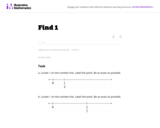
This task asks students to locate fractions on a number line.
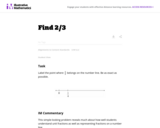
This simple-looking problem reveals much about how well students understand unit fractions as well as representing fractions on a number line.
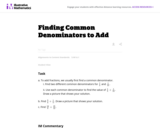
This task asks students to find and use two different common denominators to add the given fractions. The purpose of this question is to help students realize that they can use any common denominator to find a solution, not just the least common denominator.